|
|
Post by Brian Barnes on Oct 23, 2008 17:14:53 GMT
Hello Friends, Well, I do believe that I've made another interesting discovery within the genus Byblis, that to my knowledge is undocumented until now. A full report on my findings and experiments can be viewed on The Florida Carnivorous Plant Society website under 'The Byblis Chronicles'. Here's a direct link to the page; www.floridacarnivorousplantsociety.org/thebyblischronicles.htmHappy Growing, Brian Barnes, President/FCPS. |
|
sweetpea
Full Member
MOLLIE RILSTONE
Posts: 163
|
Post by sweetpea on Oct 24, 2008 15:47:35 GMT
Konnichiwa Barnes-san, About “the scent”, I obtained many variations of tropical Byblis from Mr. Allen Lowrie. Many of mauve flower colour variations: presence (unpleasant) Pink flower colour smaller variations: absent A few pink flower colour giant variations from Pago area: presence (not unpleasant, less pleasant than perfume) Photo 1: one of cultivars that was made by Isao Takai (12cm pot pink flower colour smaller variation) Photo 2: one variation of Pago giant (15cm pot, normal ploid) Photo 3: left hand; ”giant plants to 50cm tall” Pago, Kimberley right hand; “outer flower surface whitish” Honeymoon Beach, Kimberley both are normal ploid. Photo 1&2: there was one plant in each pot. Good Growing, Photo 1 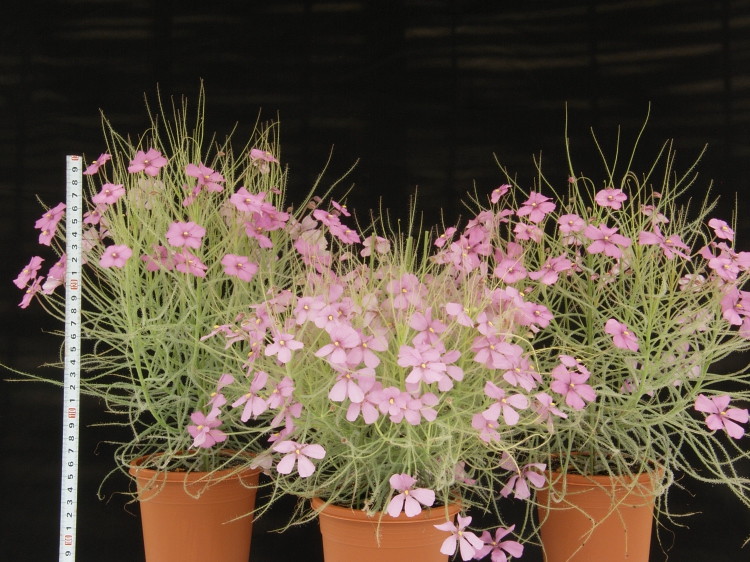 Photo 2 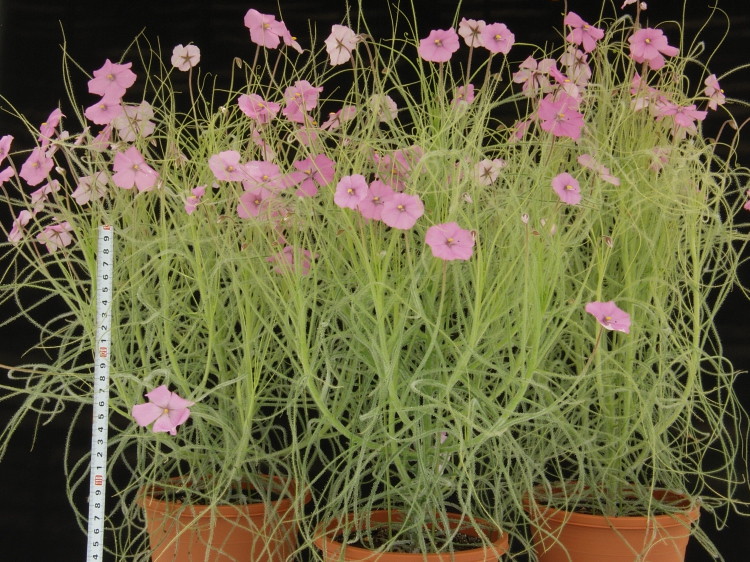 Photo3 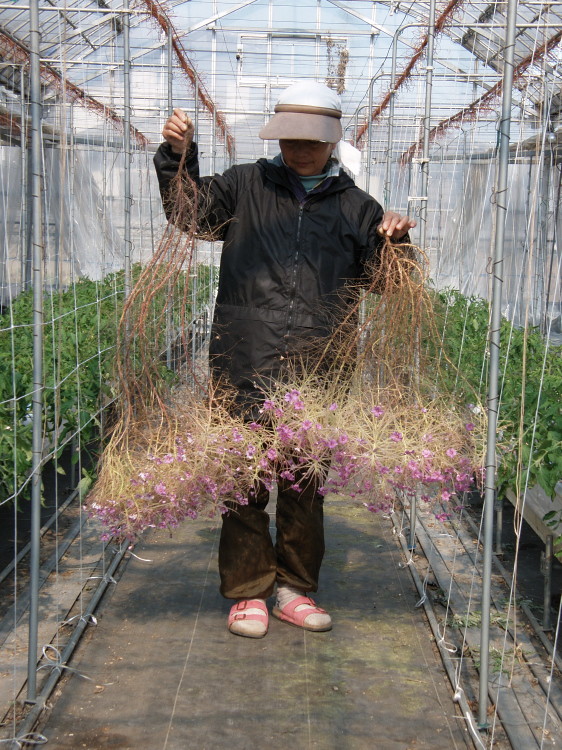 |
|
|
|
Post by Brian Barnes on Oct 24, 2008 20:02:55 GMT
Hello, it's great to hear from you! Excellent, some very nice specimens there, thanks for sharing them.  Did you notice that the scent grew stronger if the plants were shaken or disturbed? Did the plants branch out on their own, or were they clipped at the tops to induce branching? Happy Growing, Brian. |
|
sweetpea
Full Member
MOLLIE RILSTONE
Posts: 163
|
Post by sweetpea on Oct 25, 2008 15:40:41 GMT
Konnichiwa Barnes-san,
Yes you are right in judging so. If the plants are shaken, the scent grows stronger. I noticed about it in 1999.
The plants branched out on their own. Please see the last photo in the thread 1634.
Good Growing
|
|
|
|
Post by grandmaster on Oct 25, 2008 21:42:31 GMT
This is the species Allen Lowrie commented on during his second talk at the recent ICPS conference in Sydney, it is yet to be formally discribed and I take it you are the Japanese grower he referred to that is going to TC these things and sell them as pot plants for the Japanese market.
|
|
|
|
Post by pinglover on Oct 25, 2008 23:57:07 GMT
Oh please rush those into production so that we Americans can get our hands on them sooner.
My favorite is the plant in the first photo to the far left. Love the shape of the petals and the deeper mauve color.
Very nice healthy looking plants you have there. I had not seen photos of these plants before so thank you for sharing your images.
|
|
sweetpea
Full Member
MOLLIE RILSTONE
Posts: 163
|
Post by sweetpea on Oct 27, 2008 0:20:27 GMT
Konnichiwa pinglover-san,
The three plants in the first photo are same cultivar.
You might think they were too much different as calling one cultivar. If you should sow some seeds from one clone of native origin, you would surely find much wide range of difference.
I believe cp grower would very much appreciate this phenomenon.
I guess Mr. Christian Dietz mentioned same thing in the thread 2355.
On the other hand, for some purpose, I have inconvenience.
The characters of three plants in the first photo place the border of thousands clones of this cultivar. For making the character uniform (although such low level degree), it needed near ten years.
Good Growing
|
|
|
|
Post by pinglover on Oct 27, 2008 15:14:52 GMT
A hybridizer I am not but I appreciate those who are. Now get going and get those plants into production so they make their way over to our side of the world  I've not tried to grow Byblis before but would definitely be interested in doing so. |
|
|
|
Post by BarryRice on Oct 28, 2008 22:02:29 GMT
What wonderful work. Japan certainly is leading us all in excellence in Byblis!
Cheers
Barry
|
|
cindy
Full Member
Posts: 226
|
Post by cindy on Oct 29, 2008 8:46:35 GMT
I thought only Nepenthes would take over my very limited growing area. LOL
Thank you, sweetpea-san. For sharing with us the photos. May I ask a few questions?
1. In what conditions are the plants growing in?
2. Is the humidity high i.e. >50%?
3. Are the plants receiving direct sunlight?
4. How do these plants do for you during winter?
domo arigato gozaimasu
|
|
|
|
Post by Brian Barnes on Oct 29, 2008 14:51:33 GMT
Hello Sweetpea, Your work with this genus is outstanding!  Here's a few photos showing the diversity amongst seedlings of my cultivar Byblis 'Goliath'. As you stated, from seed there are a wide range of growth forms that can be achieved. Some with long internodes between leaves and some with very bushy, compact form. Variation amongst flowers between clones is simply amazing. Due to such extreme variation, I'm beginning to wonder if such desired characteristics would remain consistent in tissue culture. The plants in these photos are from one single seed capsule harvested from a shorter, bushier form that I've been working with for quite some time. Note the bushy traits beginning to appear on the lower main stem of the plants. The "bushier" plant on the right is a result of multiple selective cross-breeding efforts amongst clones.    You are most definitely correct in saying that it takes a while for desired characteristics to appear and stabilize. Rooted cuttings from desired forms appear to remain more true than from seed. Curiously, I have noticed that despite methods of propagation, the distinctive pulvinic trait of Byblis 'Goliath' is passed on to seedlings and clones alike...A full documentation of the anomaly can be viewed here; www.floridacarnivorousplantsociety.org/thebyblischronicles.htmHere are some photos showing the diversity of flower forms within the fore-mentioned cultivar. Notice extreme differences in fimbrate petal edges and size, along with slightly different color shades amongst clones. I've also noticed that successfully pollinated flowers will take on a blueish tint a few days before petal drop occurs;      Happy Growing, Brian Barnes. |
|
|
|
Post by grandmaster on Oct 29, 2008 19:39:51 GMT
Byblis gueholii
|
|
|
|
Post by Brian Barnes on Oct 29, 2008 21:11:09 GMT
Hi Matti,
Good eye! ;D But unfortunately, Byblis guehoi (which I think you were referring to) does not have a pulvinus on the pedicels such as Byblis 'Goliath' does, nor to my knowledge is pulvinus included or documented in any of Allen's species descriptions regarding the genus Byblis.
Happy Growing,
Brian.
|
|
sweetpea
Full Member
MOLLIE RILSTONE
Posts: 163
|
Post by sweetpea on Oct 31, 2008 12:07:35 GMT
Konnichiwa pinglover-san, Barry-san, cindy-san, Barnes-san and all, 1. In what conditions are the plants growing? 2. Is the humidity high? 3. Are the plants receiving direct sunlight? Please see the photo 4: I do not use any shading throughout the year. My plastic film covered green house allows the U.V. light through. If you grow pink or pinkish mauve variations of Byblis, I recommend the use of a plastic film that allows the U.V. light to pass through or the use of clear glass for covering the greenhouse. In summer, the maximum temperature is more than 35 ° C and quite often more than 40 ° C. I do not control the humidity, but >50% humidity is typical in my greenhouse. 4. How do these plants do for you during winter? Please see the photo 3: Last February when I was tidying up the greenhouse for the 2008 Byblis growing season, I remembered the comments of a few cp growers, who in the thread 524 thought the Byblis plants that I grew were special ones. I sowed these Byblis in May 2007. The photo was taken on February 15 2008 (mid winter). They were grown in the same greenhouse as in photo 4 although the photo of my wife with the two super long plants was taken in another greenhouse. At this time, I grew cut flowers (i.e. Stocks, Dianthus…) in half of the greenhouse. The greenhouse was controlled to a maximum temperature of 25 ° C and the lowest temperature was 5 ° C. These conditions are not appropriate for pink flowered smaller variations of Byblis and for these plants I recommend low temperatures of no less than 10 ° C. For Pago giant variations and Byblis guehoi, low temperatures of 5 ° C is no problem if the Byblis are mature plants. However the flower size does become bit smaller at these lower temperatures. The cultivars that I have made are from the original characters expressed in the very impressive Byblis variations that Mr. Allen Lowrie has been distributing all over the world for many years. The only uniformity in my cultivars is my selection of good characters in my breeding program. If cp growers would like to grow special, rare and new Byblis and ones that may be described as new species or subspecies in the future by Mr. Allen Lowrie, please check both his main list and update lists (it seems the list is updated nearly every day!). He has huge numbers of Byblis variations! UNBELIEVABLE!!! The plants in photo 6 and in the right line in photo 5 are the same cultivar as photo 1. I feel this clone is near its limit in “uniformity” and “to avoid an inbreeding depression”. I also believe this cultivar is a bit too premature at this time to formally name. Photos 4, 5 & 6 were taken in 2006. The lamps in the photo 4 are not for Byblis growing, but for my night work. Please see photo 5: Sometimes a rainbow appears within the Byblis foliage on fine days. When I walk through the greenhouse this rainbow effect moves with me. This is a time of supreme bliss for me. Unfortunately, it is very difficult to take photos to illustrate this rainbow effect. Good Growing Photo 4: 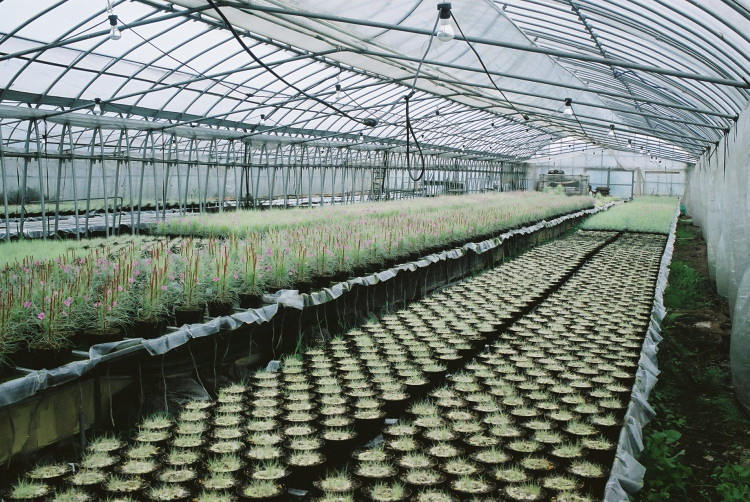 Photo 5: 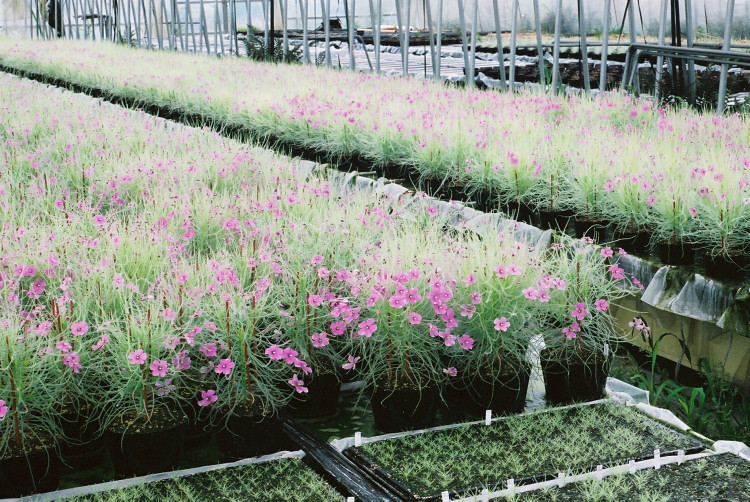 Photo 6: 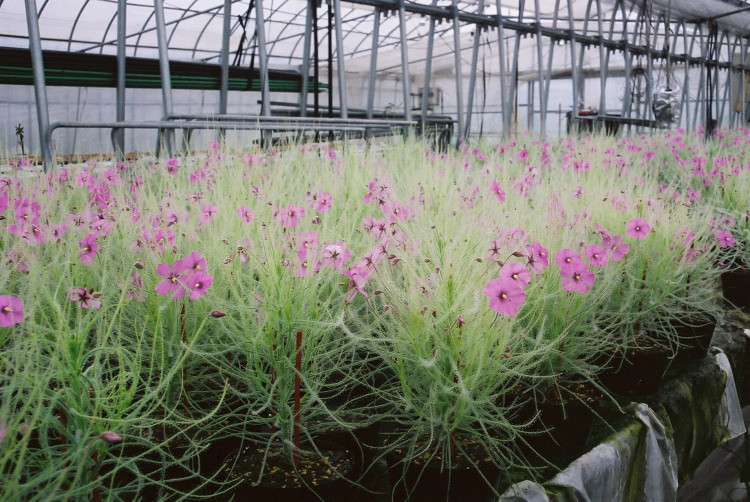 |
|
|
|
Post by pinglover on Oct 31, 2008 12:44:29 GMT
Hi Isao,
You took my breath away with those photos. That's a major "WOW" factor to see so many like that!
What are you using as a potting medium?
You've got me wanting to try some seed of this genus. Now I'll have to check around to see if I can find any for sale.
Beautiful plants!
|
|







